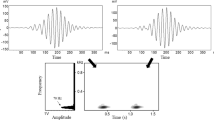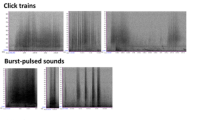Abstract
Many animal groups use sounds in reproduction in order to court mates or repel rivals. We describe the sounds and behavioural context of courtship sound production in male sand gobies, Pomatoschistus minutus, and examine the variability of acoustic parameters and the fine temporal patterning of sound units. Male sand gobies excavate a nest under a suitable solid substrate and attract females to mate, attaching the eggs to the ceiling of the nest. Before mating a female may repeatedly enter and leave a male's nest. Sounds were not detected during the courtship phase outside the nest, but were recorded when females were in the nest before spawning. Sounds were produced in 44–100% of such nest visits, varying with individual males. The sand goby sound consists of a train of pulses repeated at a rate of 23–29 pulses per second. The frequency spectrum of single pulses was continuous from 20–30 Hz to 500 Hz and reached a peak around 100 Hz. The absolute sound pressure level ranged from 118 to 138 dB re 1 µPa at 1–3 cm. The sand goby emits sound in distinct sound groups (bursts). Sound temporal features (duration, pulse repetition rate) vary systematically over the course of the burst. Within- and between-male variation of acoustic parameters was examined from sounds emitted by the male. Sound amplitude (peak-to-peak, mV) and pulse rate varied significantly among males, despite low individual stereotypy. Furthermore, sound pressure level correlated with body size. The potential informative content of acoustic parameters is discussed in the light of a possible role of the sand goby sound in mate choice.
Similar content being viewed by others
References cited
Andersson, M. 1994. Sexual selection. Princeton University Press, Princeton. 599 pp.
Baylis, J.R. 1976. Aquantitative study of the long-term courtship: II. Acomparative study of the dynamics of courtship in two new world cichlid fishes. Behaviour 59: 117–141.
Boake, C.R.B. 1989. Repeatability: its role in evolutionary studies of mating behavior. Evol. Ecol. 3: 173–182.
Connaughton, M.A., M.L. Fine & M.H. Taylor. 1997. The effects of seasonal hypertrophy and atrophy on fiber morphology, metabolic substrate concentration and sound characteristics of the weakfish sonic muscle. J. Exp. Biol. 200: 2449–2457.
Connaughton, M.A. & M.H. Taylor. 1996. Drumming, courtship, and spawning behavior in captive weakfish, Cynoscion regalis. Copeia 1996: 195–199.
Crawford, J.D., M. Hagedorn & C.D. Hopkins. 1986. Acoustic communication in an electric fish, Pollimyrus isidori (Mormyridae). J. Comp. Physiol. 159: 297–310.
Demski, L.S., J.W. Gerald & A.N. Popper. 1973. Central and peripheral mechanisms of teleost sound production. Amer. Zool. 13: 1141–1167.
Fine, M.L., H.E. Winn & B.L. Olla. 1977. Communication in fishes. pp. 472–518. In: T.A. Sebeok (ed.) How Animals Communicate, Indiana University Press, Bloomington.
Fine, M.L., P.J. Friel, D. McElroy, C.B. King, K.E. Loesser & S. Newton. 1997. Pectoral spine locking and sound production in the channel catfish Ictalurus punctatus. Copeia 1997: 777–790.
Forsgren, E. 1997. Mate sampling in a population of sand gobies. Anim. Behav. 53: 267–276.
Gerhardt, H.C. 1991. Female mate choice in treefrogs: static and dynamic acoustic criteria. Anim. Behav. 42: 615–635.
Grafen, A. 1990. Sexual selection unhandicapped by the Fisher process. J. Theor. Biol. 144: 473–516.
Haccou, P. & E. Meelis. 1992. Statistical analysis of behavioural data. Oxford University Press, Oxford. 396 pp.
Healey, M.C. 1971. The distribution and abundance of sand gobies Gobius minutus, in the Ythan Estuary. J. Zool. 163: 177–229.
Kastberger, G. 1981. Economy of sound production in piranhas (Serrasalminae, Characidae): II. Functional properties of sound emitter. Zool. Jahrb. Physiol. 85: 393–411.
Kenyon, T.N. 1994. The significance of sound interception to males of the bicolor damselfish, Pomacentrus partitus, during courtship. Env. Biol. Fish. 40: 391–405.
Kinzer, J. 1961. Ñber die Lautäusserungen der Schwarzgrundel Gobius jozo. Aquar. Terrar.-Kunde 7: 7–10.
Ladich, F., W. Brittinger & H. Kratochvil. 1992. Significance of agonistic vocalization in the croaking gourami (Trichopsis vittatus, Teleostei). Ethology 90: 307–314.
Lindström, K. 1992. Female spawning patterns and male mating success in the sand goby Pomatoschistus minutus. Mar. Biol. 113: 475–480.
Lobel, P.S. & D.A. Mann. 1995. Spawning sounds of the damselfish, Dascyllus albisella (Pomacentridae), and relationship to male size. Bioacoustics 6: 187–198.
Loesser, K.E., J. Rafi & M.L. Fine. 1997. Embryonic, juvenile, and adult development of the toadfish sonic muscle. Anat. Rec. 249: 469–477.
Lugli, M., G. Pavan & P. Torricelli. 1996. The importance of breeding vocalizations for mate attraction in a freshwater goby with a composite sound repertoire. Ethol. Ecol. Evol. 8: 343–351.
Lugli, M., P. Torricelli, G. Pavan & D. Mainardi. 1997. Sound production during courtship and spawning among freshwater gobiids (Pisces, Gobiidae). Mar. Fresh. Behav. Physiol. 29: 109–126.
Lugli, M., G. Pavan, P. Torricelli & L. Bobbio. 1995. Spawning vocalizations in male freshwater gobiids (Pisces, Gobiidae). Env. Biol. Fish. 43: 219–231.
Lugli, M. & P. Torricelli. 1999. Pre-spawning sound production in mediterranean sand-gobies (Pisces, Gobiidae). J. Fish Biol. 54: 691–694.
Magnhagen, C. & C. Kvarnemo. 1989. Big is better: the importance of size for reproductive success in male Pomatoschistus minutus (Pallas) (Pisces, Gobiidae). J. Fish Biol. 35: 755–763.
Mok, H.K. 1981. Sound production in the naked goby, Gobiosoma bosci (Pisces, Gobiidae)-a preliminary study. pp. 447–455. In: W.N. Tavolga, A.N. Popper & R.R. Fay (ed.) Hearing and Sound Communication in Fishes, Springer Verlag, New York.
Myrberg, A.A., Jr. 1981. Sound communication and interception in fishes. pp. 395–426. In: W.N. Tavolga, A.N. Popper & R.R. Fay (ed.) Hearing and Sound Communication in Fishes, Springer Verlag, New York.
Myrberg, A.A. Jr., M. Mohler & J.D. Catala. 1986. Sound production by males of a coral reef fish (Pomacentrus partitus): its significance to females. Anim. Behav. 34: 913–923.
Myrberg, A.A., Jr., S.J. Ha & M.J. Shamblott. 1993. The sounds of bicolor damselfish (Pomacentrus partitus): predictors of body size and a spectral basis for individual recognition and assessment. J. Acoust. Soc. Amer. 94: 3067–3070.
Myrberg, A.A., Jr., E. Kramer & P. Heinecke. 1965. Sound production by cichlid fishes. Science 149: 555–558.
Packard, A. 1960. Electrophysiological observations on a soundproducing fish. Nature 187: 63–64.
Schleidt, W.M. 1974. How “fixed” is the fixed action pattern. Z. Tierpsychol. 36: 184–211.
Sevenster, P. 1961. A causal analysis of a displacement activity (fanning in Gasterosteus aculeatus L.). Behaviour supplement IX: 1–170.
Siegel, S. & N.J. Castellan, Jr. 1992. Nonparametric statistics for behavioral sciences. McGraw-Hill, Milano. 477 pp.
Skoglund, C.R. 1959. Neuromuscular mechanisms of sound production in Opsanus tau. Biol. Bull. 117: 438.
Sokal, R.R. & F.J. Rohlf. 1981. Biometry. W.H. Freeman and Company, New York. 859 pp.
Takemura, A. 1984. Acoustical behaviour of the freshwater goby Odontobutis obscura. Japan. Soc. Sci. Fish. 50: 561–564.
Tavolga, W.N. 1956. Visual, chemical, and sound stimuli as cues in the sex discriminatory behavior of the gobiid fish, Bathygobius soporator. Zoologica 41: 49–64.
Tavolga, W.N. 1958. The significance of underwater sounds produced by males of the gobiid fish, Bathygobius soporator. Physiol. Zool. 31: 259–271.
Torricelli, P., M. Lugli & G. Pavan. 1990. Analysis of sounds produced by male Padogobius martensi (Pisces, Gobiidae) and factors affecting their structural properties. Bioacoustics 2: 261–276.
Author information
Authors and Affiliations
Rights and permissions
About this article
Cite this article
Lindström, K., Lugli, M. A Quantitative Analysis of the Courtship Acoustic Behaviour and Sound Patterning in Male Sand Goby, Pomatoschistus minutus . Environmental Biology of Fishes 58, 411–424 (2000). https://doi.org/10.1023/A:1007695526177
Issue Date:
DOI: https://doi.org/10.1023/A:1007695526177




